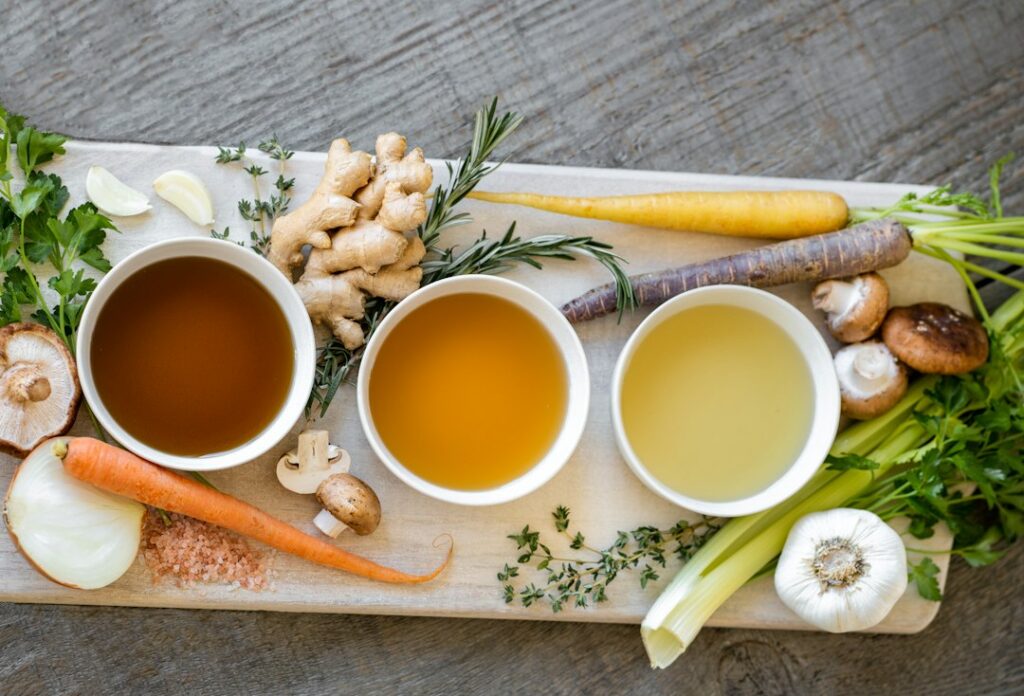Bone broth is a nutrient-rich liquid made by simmering animal bones and connective tissues in water for an extended period of time. This ancient culinary tradition has been around for centuries, with its origins dating back to prehistoric times. Throughout history, bone broth has been a staple in many cultures around the world, valued for its numerous health benefits.
Bone broth is not only delicious but also packed with essential nutrients. It is rich in collagen, gelatin, amino acids, and minerals such as calcium, magnesium, and phosphorus. These nutrients are known to support joint health, improve digestion, boost the immune system, promote healthy skin, hair, and nails, and aid in detoxification.
Making the Perfect Bone Broth: Tips and Tricks
To make the perfect bone broth, it is important to choose the right bones. Look for bones that are rich in collagen, such as beef knuckles, chicken feet, or pork bones. These collagen-rich bones will give your broth a gelatinous texture and provide the most health benefits.
Before cooking the bones, it is recommended to roast them in the oven for about 30 minutes. This step helps to enhance the flavor of the broth. Once roasted, transfer the bones to a large pot and cover them with water. Add a splash of apple cider vinegar or lemon juice to help extract the minerals from the bones.
Simmer the bones on low heat for at least 12 hours, but preferably up to 24 hours. This long cooking time allows the bones to release their nutrients into the broth. It is important to keep an eye on the pot and add more water if needed.
To add flavor and seasoning to your bone broth, you can include vegetables like onions, carrots, and celery. You can also add herbs and spices such as bay leaves, thyme, and black peppercorns. These ingredients will enhance the taste of your broth and provide additional health benefits.
The Science Behind Bone Broth: Nutrients and Healing Properties
Bone broth is packed with essential nutrients that are beneficial for our overall health. It is a rich source of collagen, which is the most abundant protein in our bodies. Collagen helps to support healthy skin, hair, nails, and joints. It also plays a role in gut health by supporting the integrity of the intestinal lining.
In addition to collagen, bone broth contains gelatin, which is derived from collagen during the cooking process. Gelatin has been shown to improve digestion and promote gut health. It also helps to reduce inflammation and support joint health.
Bone broth is also rich in amino acids, which are the building blocks of proteins. These amino acids, such as glycine and proline, have anti-inflammatory properties and support the immune system. They also play a role in detoxification by supporting liver function.
Research studies have shown that bone broth can help reduce joint pain and inflammation, improve gut health, support healthy skin, hair, and nails, boost the immune system, and aid in detoxification. These studies have provided scientific evidence to support the traditional use of bone broth for its healing properties.
Bone Broth vs. Stock: What’s the Difference?
While bone broth and stock are often used interchangeably, there are some key differences between the two. Stock is typically made by simmering bones with some meat attached to them, along with vegetables and aromatics. It is cooked for a shorter period of time compared to bone broth.
Bone broth, on the other hand, is made by simmering bones for an extended period of time, usually 12-24 hours or even longer. It is cooked until the bones break down and release their nutrients into the broth. Bone broth has a thicker consistency compared to stock due to the gelatin that is extracted from the bones during the cooking process.
When it comes to usage, bone broth is often consumed on its own as a nourishing beverage or used as a base for soups, stews, and sauces. Stock, on the other hand, is commonly used as a base for soups and sauces, but it can also be consumed on its own.
Top 5 Bone Broth Recipes for Beginners
1. Basic Bone Broth Recipe:
– Ingredients: beef bones, water, apple cider vinegar, vegetables (onions, carrots, celery), herbs and spices (bay leaves, thyme, black peppercorns)
– Instructions: Roast the beef bones in the oven for 30 minutes. Transfer the bones to a large pot and cover with water. Add a splash of apple cider vinegar. Simmer on low heat for 12-24 hours. Add vegetables, herbs, and spices. Continue simmering for another hour. Strain the broth and discard the solids.
2. Chicken Bone Broth Recipe:
– Ingredients: chicken bones (such as carcass or chicken feet), water, apple cider vinegar, vegetables (onions, carrots, celery), herbs and spices (bay leaves, thyme, black peppercorns)
– Instructions: Roast the chicken bones in the oven for 30 minutes. Transfer the bones to a large pot and cover with water. Add a splash of apple cider vinegar. Simmer on low heat for 12-24 hours. Add vegetables, herbs, and spices. Continue simmering for another hour. Strain the broth and discard the solids.
3. Beef Bone Broth Recipe:
– Ingredients: beef bones (such as knuckles or marrow bones), water, apple cider vinegar, vegetables (onions, carrots, celery), herbs and spices (bay leaves, thyme, black peppercorns)
– Instructions: Roast the beef bones in the oven for 30 minutes. Transfer the bones to a large pot and cover with water. Add a splash of apple cider vinegar. Simmer on low heat for 12-24 hours. Add vegetables, herbs, and spices. Continue simmering for another hour. Strain the broth and discard the solids.
4. Fish Bone Broth Recipe:
– Ingredients: fish bones (such as heads or carcasses), water, apple cider vinegar, vegetables (onions, carrots, celery), herbs and spices (bay leaves, thyme, black peppercorns)
– Instructions: Roast the fish bones in the oven for 30 minutes. Transfer the bones to a large pot and cover with water. Add a splash of apple cider vinegar. Simmer on low heat for 4-6 hours. Add vegetables, herbs, and spices. Continue simmering for another hour. Strain the broth and discard the solids.
5. Vegetable Bone Broth Recipe:
– Ingredients: vegetable scraps (such as onion peels, carrot tops, celery leaves), water, apple cider vinegar, herbs and spices (bay leaves, thyme, black peppercorns)
– Instructions: Place the vegetable scraps in a large pot and cover with water. Add a splash of apple cider vinegar. Simmer on low heat for 2-4 hours. Add herbs and spices. Continue simmering for another hour. Strain the broth and discard the solids.
Elevating Basic Soups with Bone Broth: Creamy Tomato Soup and More

Bone broth can be used to elevate basic soups and add depth of flavor and nutrition. One example is creamy tomato soup made with bone broth.
Creamy Tomato Soup Recipe with Bone Broth:
– Ingredients: bone broth (chicken or vegetable), canned tomatoes, onion, garlic, butter or olive oil, heavy cream or coconut milk, salt, pepper
– Instructions: In a large pot, sauté the onion and garlic in butter or olive oil until softened. Add the canned tomatoes and bone broth. Simmer for 20-30 minutes. Use an immersion blender or regular blender to puree the soup until smooth. Stir in the heavy cream or coconut milk. Season with salt and pepper to taste.
Other soup recipes that can be improved with bone broth include butternut squash soup, potato leek soup, and mushroom soup. The rich flavor and nutrients from the bone broth will take these soups to the next level.
Soup Cooking Secrets: How to Achieve the Perfect Consistency and Flavor
To achieve the perfect soup consistency, it is important to control the amount of liquid in the recipe. If you prefer a thicker soup, use less liquid or simmer the soup for a longer period of time to allow some of the liquid to evaporate. On the other hand, if you prefer a thinner soup, add more liquid or use a blender to puree some of the ingredients.
To enhance the flavor of your soup, it is important to season it properly. Start by sautéing onions and garlic in butter or olive oil before adding other ingredients. This will help to develop a rich base flavor. Add herbs and spices such as bay leaves, thyme, and black pepper to enhance the taste of your soup. Taste and adjust the seasoning as needed.
Improving Soup Recipes with Bone Broth: Chicken Noodle Soup and More
Chicken noodle soup is a classic comfort food that can be made even better with bone broth.
Chicken Noodle Soup Recipe with Bone Broth:
– Ingredients: bone broth (chicken), chicken breast or thighs, carrots, celery, onion, garlic, egg noodles, salt, pepper
– Instructions: In a large pot, sauté the onion and garlic in butter or olive oil until softened. Add the carrots, celery, and bone broth. Simmer for 20-30 minutes. Add the chicken and cook until cooked through. Remove the chicken and shred it. Return the shredded chicken to the pot. Add the egg noodles and cook until tender. Season with salt and pepper to taste.
Other soup recipes that can be improved with bone broth include vegetable soup, minestrone soup, and beef stew. The addition of bone broth will enhance the flavor and provide additional nutrients to these hearty dishes.
How to Incorporate Bone Broth into Your Daily Diet
There are many ways to incorporate bone broth into your daily diet. You can simply drink it on its own as a nourishing beverage. Heat up a cup of bone broth and sip it like you would a cup of tea or coffee.
Bone broth can also be used as a base for soups, stews, and sauces. Use it in place of water or stock in your favorite recipes to add depth of flavor and nutrition.
You can also use bone broth as a cooking liquid for grains such as rice or quinoa. This will infuse the grains with the nutrients from the bone broth and add a delicious flavor.
Another way to consume bone broth is by using it as a base for smoothies or protein shakes. Simply blend bone broth with your favorite fruits, vegetables, and protein powder for a nutritious and filling meal.
The Ultimate Bone Broth Guide for a Healthier You
In conclusion, bone broth is a nutrient-rich liquid that has been valued for its health benefits for centuries. It is packed with essential nutrients such as collagen, gelatin, amino acids, and minerals that support joint health, improve digestion, boost the immune system, promote healthy skin, hair, and nails, and aid in detoxification.
To make the perfect bone broth, choose bones that are rich in collagen, roast them before cooking, simmer them for an extended period of time, and add flavor and seasoning. Bone broth can be used as a base for soups, stews, and sauces, or consumed on its own as a nourishing beverage.
By incorporating bone broth into your daily diet, you can reap the numerous health benefits and enjoy delicious and nutritious meals. So why not give bone broth a try and start your journey to a healthier you?
Looking for more delicious recipes to try? Check out this Mini Meatloaf Recipe from Relish the Daily. It’s a perfect comfort food option that pairs well with The Ultimate Bone Broth Guide: Health Benefits and Recipes.





